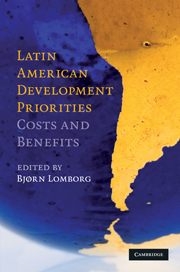Book contents
- Frontmatter
- Contents
- List of figures
- List of tables
- List of contributors
- Acknowledgments
- Abbreviations and acronyms
- Expert panel findings
- Introduction
- Democracy
- Education
- Employment and social security
- Environment
- Fiscal problems
- Health
- Infrastructure
- Poverty
- Public administration
- 9 Public administration and institutions in the LAC region
- 9.1 Public administration: an alternative view
- Violence and crime
- Conclusion
9 - Public administration and institutions in the LAC region
Published online by Cambridge University Press: 05 June 2012
- Frontmatter
- Contents
- List of figures
- List of tables
- List of contributors
- Acknowledgments
- Abbreviations and acronyms
- Expert panel findings
- Introduction
- Democracy
- Education
- Employment and social security
- Environment
- Fiscal problems
- Health
- Infrastructure
- Poverty
- Public administration
- 9 Public administration and institutions in the LAC region
- 9.1 Public administration: an alternative view
- Violence and crime
- Conclusion
Summary
Introduction
Most LAC countries have democratic constitutions, functioning bureaucracies, and professional judiciaries. The institutions are in place, but their operation varies widely across the region. Some institutions function well in some countries, sometimes surpassing the performance of those in comparable, wealthier countries. Others, however, are plagued with waste and corruption, impose needless costs on the population, and do not accomplish their missions well. I highlight the most pressing problems in the LAC region and discuss potential solutions, drawing on existing experiments and reform initiatives. Reform priorities ought to differ across countries. Although most occupy the middle range on cross-country measures of corruption and government effectiveness and in terms of economic wellbeing and growth, the key pressure points vary. I highlight good and bad performers on a number of dimensions and argue that broad regional similarities imply that successes in one country can provide lessons for reformers elsewhere.
I concentrate on public administration and the judiciary, but improvements in these areas can complement other types of reform. For example, Latin American democracies have traditionally had weak legislatures. If legislative capacity is strengthened, it can play a stronger oversight role with respect to the executive. Similarly, if violence and organized crime make ordinary state functioning problematic, then improved law enforcement is a necessary condition for other types of reform to succeed.
- Type
- Chapter
- Information
- Latin American Development PrioritiesCosts and Benefits, pp. 515 - 590Publisher: Cambridge University PressPrint publication year: 2010



